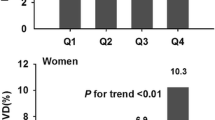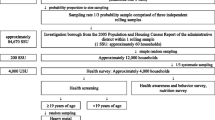Summary
Lead concentration in whole blood of a representative sample of 471 subjects aged 20 to 74 years and living in Basle was determined in 1989/90 by flame atomic absorption spectrophotometry. The participants in the cross-sectional study filled in a questionnaire on demographic factors, nutrition and drinking habits. The age-adjusted geometrical mean blood lead level was 0.38±0.19 μmol/litre of whole blood for males, and 0.29±0.17 μmol/litre for females. The average lead burden was about 30% below the mean concentration found in a comparable population in Western Switzerland five years earlier. Lead emissions in Switzerland decreased by about 40% from 1984 to 1990 through restriction of lead in petrol. This offers the most plausible explanation for the low blood lead levels found in Basle. Sex, age, occupation (employment in painting or printing, construction or the metal processing industry), smoking and alcohol intake (especially wine consumption) were identified as independent blood lead predictors in a multiple linear regression analysis. Participants who consumed alcohol daily had blood lead concentrations on average 12% higher than those of abstinent subjects. Regular smokers had an unconfounded average blood lead level 8% above that of people who never smoked. Place of residence and hourly frequency of cars in that area were not identified as independent predictors in the model. The analysis of 99 different wines on the market in Basle showed an average lead concentration of 50±17 μg/litre wine. Compared to an estimated 25 μg daily nutritional intake of lead in Switzerland the value appeared to be high. The hypothesis is presented that there is a causal relationship between lead in wine and lead in blood.
Résumé
La plombémie d'un échantillon représentatif de la population (n=471) âgée de 20 à 74 ans et vivant à Bâle a été déterminée par spectrophotométrie à flamme en 1989–1990. Les participants à cette étude transversale ont rempli un questionnaire relevant des données démographiques, les habitudes en matière de nutrition, de consommation alcoolique et tabagique. La moyenne géométrique de la plombémie, ajustée pour l'âge, etait de 0,38±0,19 μmol/l pour les hommes et de 0,29±0,17 μmol/l pour les femmes. Ces valeurs moyennes étaient d'environ 30% inférieures à celles mesurées dans une population comparable de Suisse orientale cinq ans auparavant. Les émissions de plomb en Suisse ont diminué d'environ 40% entre 1984 et 1990, suite à la diffusion de plus en plus large des carburants sans plomb, ce qui représente l'explication la plus plausible aux valeurs de plombémie basses mesurées à Bâle. Le sexe, l'âge, la profession (peintres en bâtiment, imprimeurs, employés de la construction ou de la métallurgie), les habitudes tabagiques et la consommation d'alcool (de vin en particulier) ont été identifiés comme des prédicteurs indépendants de la plombémie dans une analyse de régression linéaire multiple. Les consommateurs quotidiens d'alcool avaient en moyenne une plombémie de 12% supérieure aux abstinents et les fumeurs habituels, une valeur de 8% plus élevée que les sujets n'ayant jamais fumé. Le lieu de résidence et la densité du trafic automobile à proximité du domicile n'ont pas été identifiés comme des prédicteurs indépendants. L'analyse de 99 vins disponibles sur le marché bâlois a révélé une concentration de plomb moyenne de 50±17 μmol/l de vin. Comparée à un apport par les aliments estimé à 25 μg/j en Suisse, cette valeur est élevée. L'hypothèse d'une relation causale entre plombémie et consommation de vin est émise.
Zusammenfassung
Im Rahmen einer Querschnittstudie wurde 1989/90 die Bleibelastung der 20–74jährigen Bevölkerung von Basel-Stadt bestimmt. Für die Gehaltsanalyse mittels Atomabsorptions-Spektrophotometrie wurde einer repräsentativen Stichprobe (n=471) venöses Blut entnommen. Mittels Fragebogen wurden soziodemographischer Hintergrund, Ernährungsgewohnheiten, Rauchen und Alkoholkonsum erfasst. Die alterskorrigierte mittlere (geometrische) Bleibelastung des Kollektivs betrug 0.38±0.19 μg/l Vollblut für Männer und 0.29±0.17 μmol/l für Frauen. Die mittlere Bleibelastung betrug rund 30% weniger als 1984 in einem vergleichbaren Westschweizer Kollektiv. Seit 1984 gingen die Bleiemissionen durch den Verkehr in der Schweiz um 40% zurück. Somit ist der erfolg-reich gesenkte Bleiausstoss die wahrscheinlichste Ursache für die heute vergleichsweise niedrige Belastung in Basel. In einer multiplen linearen Regressionsanalyse wurden Geschlecht, Alter, Beruf (Tätigkeit in Metallverarbeitung, Maler-,Druckerei-und Baugewerbe), Rauchen und Alkoholkonsum (insbesondere Wein) als unabhängige Determinanten identifiziert, die beim Einzelnen zu einer Blutbleibelastung über das durch die Umwelt gegebene Grundmass hinaus führen können. Teilnehmer, die täglich Alkohol konsumierten, hatten durchschnittlich 12% höhere Blutbleiwerte als abstinente Personen. Regelmäßige Raucher hatten 8% höhere mittlere Blutbleiwerte als Personen, die nie geraucht hatten. Das Verkehrsaufkommen an der Wohnadresse konnte nicht mit dem Blutbleigehalt assoziiert werden. Die Analyse von 99 Weinen des Basler Marktes zeigte in der Tat, dass der mittlere Bleigehalt mit 50±17 μg/l hoch ist, verglichen mit der für die Schweiz geschätzten täglichen Nahrungs-Bleizufuhr von 25 μg. Dies deutet auf einen Kausalzusammenhang zwischen Blei im Wein und-bei regelmässigem Weinkonsum — im Blut hin. Ein individueller Ansatzpunkt für die Prävention einer unnötig hohen Bleibelastung scheint damit identifiziert.
Similar content being viewed by others
References
Annest JL, Pirkle JL, Makuc D, Neese JW, Bayse DD, Kovar MG. Chronological trend in blood lead levels between 1976 and 1980. N Engl J Med 1983;308:1373–1377.
Rabinowitz MB, Needleman HL. Petrol sales and umbilical cord blood lead levels in Boston, Massachusetts. Lancet 1983;1:63.
Elinder CG, Friberg L, Lind B, Nilsson B, Svartengren M, Oevermark I. Decreased blood lead levels in residents of Stockholm for the period 1980–1984. Scand J Work Environ Health 1986;12:114–120.
Rickenbach M, Wietlisbach V, Berode M, Guillemin M. La plombémie en Suisse en 1985: résultats de l'enquête MONICA. Soz Präventivmed 1987;32:87–90.
Berode M, Wietlisbach V, Rickenbach M, Guillemin M. Lifestyle and environmental factors as determinants of blood lead levels in a Swiss population. Environ Res 1991;55:1–17.
BUWAL Bundesamt für Umwelt, Wald und Landschaft. Vom Menschen verursachte Schadstoff-Emissionen in der Schweiz 1950–2010. Schriftenreihe Umweltschutz 1987;76.
Roberts J, Mahaffey KR, Annest JL. Blood lead levels in general populations. In: Mahaffey KR. Dietary and environmental lead: human health effects. Amsterdam, Elsevier Science Publishers, 1985;355:72.
Hunter J. The distribution of lead. In: Mahaffey KR. Dietary and environmental lead: human health effects. Amsterdam, Elsevier Science Publishers, 1985; 96–126.
Lehnert G, Szadkowski D, Die Bleibelastung des Menschen. Weinheim, Verlag Chemie 1983; 20–48.
Bodenmann A, Ackermann-Liebrich U, Keller U. Fleischkonsum und Serum-Cholesterinkonzentration. Dtsch Med Wschr 1991;116:1089–1094.
Zemp E. Frauen und Gesundheit. Ergebnisse der Gesundheitsbefragung SOMIPOPS. Dissertation Medizinische Fakultät der Universität Basel 1988.
Muster E. Zahlen und Fakten zu Alkohol- und Drogenproblemen 1988. Lausanne, Schweizerische Fachstelle für Alkoholprobleme 1988.
MONICA-Suisse. Première enquête de population dans les cantons de Vaud, Fribourg et Tessin 1984–1986. Soz Präventivmed supp 1987;32:52–86.
Cohen J. A coefficient of agreement for nominal scales. Educational and Psychological Measurement 1960;20:37–46.
Mitchell DG, Ryan FJ, Aldous KM. The precise determination of lead in whole blood by solvent extraction-atomic absorption spectrometry. Atomic Absorption Newsletter 1972;11:120–121.
Gruner und Partner AG. Verkehrslärm. Lärmbelastungsplan des Kantons Basel-Stadt. Basel 1987.
Probst-Hensch N, Wagmann M, Herrmann A. Monitoring-Programm Schwermetalle in Lebensmitteln. IV. Blei in Weinen auf dem Schweizer Markt. Teil A: Analytische Qualitätskontrolle. Mitt Gebiete Lebensm Hyg 1991;82:159–173.
Grandjean P. Blood lead concentrations reconsidered. Nature 1981;291:188.
Knutti R, Zimmerli B. Untersuchung von Tagesrationen aus schweizerischen verpflegungsbetrieben. Mitt Gebiete Lebensm Hyg 1985;76:206–232.
Quinn M. Factors affecting blood lead concentrations in the UK: results of the EEC Blood Lead Surveys, 1979–1981. Int J Epidemiol 1985;14:420–431.
Moore MR. Sources of lead exposure. In: Lansdown R, Yule W. The lead debate: the environment, toxicology and child health. London, Sydney, Croom Helm Ltd. 1986; 96–126.
Kantonales Laboratorium Basel-Stadt. Schwermetallgehalte im Trinkwasser. In: Die Durchführung der Lebensmittelkontrolle in der Schweiz im Jahre 1984. Mitt Gebiete Lebensm Hyg 1984;75:312–314.
Elwood PC, Phillips KM, Lowe N, Phillips JK, Toothill C. Hardness of domestic water and blood lead levels. Human Toxicol 1983;2:645–648.
Mahaffey KR. Factors modifying susceptibility to lead toxicity. In: Mahaffey KR. Dietary and environmental lead: human health effects. Amsterdam, Elsevier Science Publishers, 1985; 373–419.
Rickenbach M, Wietlisbach V, Berode M, Guillemin M, Probst-Hensch N. Moins de plomb dans l'essence, moins de plomb dans le sang. Submitted for publication to Bundesamt für Gesundheitswesen: Bulletin.
Olsen NB. Indicators of lead exposure in an adult Danish suburban population. Dan Med Bull 1981;28:168–176.
Huel G, Boudène C, Jouan M, Lazar P. Assessment of exposure to lead of the general population in the French community through biological monitoring. Int Arch Occup Environ Health 1986;58:131–139.
Mahaffey KR, Annest JL, Roberts J, Murphy RS. National estimates of blood lead levels: United States, 1976–1980. N Engl J Med 1982;307:573–579.
Pocock SJ, Shaper AG, Walker M, et al.. Effects of tap water lead, water hardness, alcohol, and cigarettes on blood lead concentrations. J Epidemiol Commun Hlth 1983;37:1–7.
Grandjean P, Hollnagel H, Hedegaard L, Christensen JM, Larsen S. Blood lead-blood pressure relations: alcohol intake and hemoglobin as confounders. Am J Epidemiol 1989;129:732–739.
Grandjean P. Aspekte der Arbeitshygiene im Baugewerbe. In: WHO Regionalbüro für Europa. Kopenhagen, EURO-Berichte und Studien, 1986.
Ewers U, Brockhaus A, Dolgner R, et al. Blutblei- und Blutcadmiumkonzentrationen bei 55–66jährigen Frauen aus verschiedenen Gebieten Nordrhein-Westfalens. Entwicklungstrends 1982–1988. Zbl Hyg 1990;189:405–418.
Brockhaus A, Freier I, Ewers U, Baginski B, Kraemer U, Dolgner R. Epidemiologische Untersuchungen zur ökologischen Bleibelastung von männlichen Grosstadtbewohnern in Nordwestdeutschland. Int Arch Occup Environ Health 1980;46:59–70.
Watanabe T, Kasahara M, Nakatsuka H, Ikeda M. Cadmium and lead contents of cigarettes produced in various areas of the world. Sci Total Environ 1987;66:29–37.
Bortoli A, Fazzin G, Marchiori M, Trabuio G, Zotti S. High levels of Pb-B und Cd-B induced by alcohol and smoke. In: Lekkas TD. Heavy metals in the environment: International conference, Athens, September 1985. Edinburgh, CEP Consultants Ltd., 1985; 439–441.
Grandjean P, Olsen NB, Hollnagel H. Influence of smoking and alcohol consumption on blood lead levels. Int Arch Occup Environ Health 1981;48:391–397.
Elinder CG, Lind B, Nilsson B, Oskarsson A. Wine — an important source of lead exposure. Food Add Contam 1988;5:641–644.
Sherlock JC, Pickford J, White GF Lead in alcoholic beverages. Food Add Contam 1986;3:347–354.
Fahrenkrug H, Mueller R. Gesünder ins Jahr 2000? Eine Untersuchung der Schweizerischen Fachstelle für Alkoholprobleme (SFA) zu Gesundheit und Alkoholkonsum der 15–74jährigen Schweizer Bevölkerung. ISPA-Press, 1990.
Smart GA, Pickford J, Sherlock JC. Lead in alcoholic beverages: a second survey. Food Add Contam 1990;7: 93–99.
Bundesamt für Gesundheitswesen: Bulletin, Bern 1992; 10.
Levin R. Reducing lead in drinking water: a benefit analysis. Office of Policy, Planning and Evaluation. Washington, U.S. Environmental Protection Agency, 1986.
Royce SE, Needleman HL. Case studies in environmental medicine. Lead toxicity. Atlanta, U.S. Department of Health and Human Services, Agency for Toxic Substances and Disease Registry, 1990.
Author information
Authors and Affiliations
Rights and permissions
About this article
Cite this article
Probst-Hensch, N., Braun-Fahrlaender, C., Bodenmann, A. et al. Alcohol consumption and other lifestyle factors: Avoidable sources of excess lead exposure. Soz Präventivmed 38, 43–50 (1993). https://doi.org/10.1007/BF01318459
Issue Date:
DOI: https://doi.org/10.1007/BF01318459




